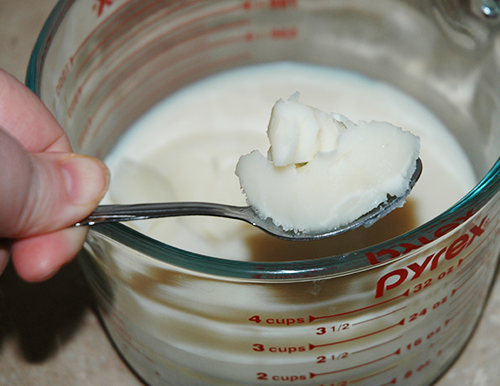 One the the many benefits of making your own meat stocks is all the wonderful fat rendered during the process. A lot of people make the mistake of discarding the fat, thinking that it is unhealthy and that there is no use for it anyway. This is a big mistake. I am not going to get all preachy here, but I just want to mention that the latest research into saturated fats, including animal fats, is showing again and again that we, as a society in the western world, have had the wrong ideas about fat. This, some speculate, may even help explain the growing obesity problems in the world. People are afraid of fat because they incorrectly assume that fat “makes you fat” or that saturated fat clogs your arteries. The truth, it seems, is that saturated fats are not the enemy. In fact eating saturated fats seems to help maintain good cholesterol counts if consumed as a part of a healthy diet, especially if that diet is not high in sugar and other carbohydrates. Okay, I am not going to go into any more detail on that subject right now, because this is a “how to” post, not a diet advice post. I just really wanted to say these things because I think that animal fat is so important not only for health, but in cooking in general. It is the best thing for sauteing anything. If you have enough, you can also use it to deep fry, and you will have the best results you have ever had. Just make some eggs with rendered fat and you will wonder how you ever did without. Also, if you use cast iron skillets, nothing seasons them better. Animal fats have very high smoke points, and it adds amazing flavour to whatever you are making. I used to use olive oil for most of my sauteing. No more. Now it is usually either rendered animal fat, coconut oil, or butter.
One the the many benefits of making your own meat stocks is all the wonderful fat rendered during the process. A lot of people make the mistake of discarding the fat, thinking that it is unhealthy and that there is no use for it anyway. This is a big mistake. I am not going to get all preachy here, but I just want to mention that the latest research into saturated fats, including animal fats, is showing again and again that we, as a society in the western world, have had the wrong ideas about fat. This, some speculate, may even help explain the growing obesity problems in the world. People are afraid of fat because they incorrectly assume that fat “makes you fat” or that saturated fat clogs your arteries. The truth, it seems, is that saturated fats are not the enemy. In fact eating saturated fats seems to help maintain good cholesterol counts if consumed as a part of a healthy diet, especially if that diet is not high in sugar and other carbohydrates. Okay, I am not going to go into any more detail on that subject right now, because this is a “how to” post, not a diet advice post. I just really wanted to say these things because I think that animal fat is so important not only for health, but in cooking in general. It is the best thing for sauteing anything. If you have enough, you can also use it to deep fry, and you will have the best results you have ever had. Just make some eggs with rendered fat and you will wonder how you ever did without. Also, if you use cast iron skillets, nothing seasons them better. Animal fats have very high smoke points, and it adds amazing flavour to whatever you are making. I used to use olive oil for most of my sauteing. No more. Now it is usually either rendered animal fat, coconut oil, or butter.
Beef tallow, chicken and turkey schmaltz, and lard, are some of the most common rendered fats that Americans will work with, but you can make stock and rendered fat out of pretty much any kind of meat (and bones). No matter what you are using, the process is more or less the same. If desired, roast the bones or carcass, or otherwise put the raw bones, carcass, and optional meat into a stock pot, add aromatic vegetables, if desired, simmer for anywhere from 6 to 24 hours, strain the stock, and let it cool. Here you will find all of my stock recipes and you can check those out if you would like more detailed instructions. Once you have completed these steps, you can go onto to the following steps to clean that fat and prepare it for use.
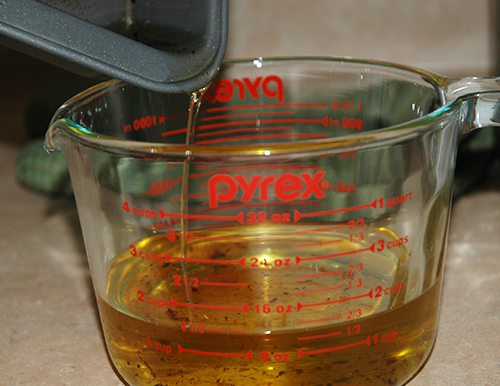 So, I prepared this article while making Beef Stock. Therefor the fat that I am producing today is known as beef tallow. Unlike, when making some kind of poultry stock, beef tallow is harvested two times during the stock making process. When making beef stock, you first roast the bones. During roasting a lot of fat is rendered from the marrow. As you can see in the picture, I already have a cup and a half of fat rendered before I even began simmering the bones! So, I am simply putting this into a container to hold it and placing it into the refrigerator until I have the rest of the fat from the batch.
So, I prepared this article while making Beef Stock. Therefor the fat that I am producing today is known as beef tallow. Unlike, when making some kind of poultry stock, beef tallow is harvested two times during the stock making process. When making beef stock, you first roast the bones. During roasting a lot of fat is rendered from the marrow. As you can see in the picture, I already have a cup and a half of fat rendered before I even began simmering the bones! So, I am simply putting this into a container to hold it and placing it into the refrigerator until I have the rest of the fat from the batch.
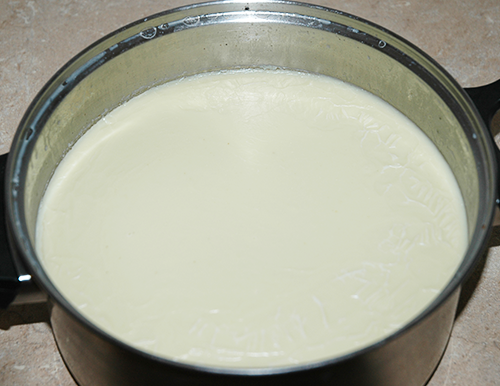 After the finished stock is strained and chilled, it will have a solid layer of fat on top. Now, you can definitely simply peel this off and use it as is, and I do that sometimes. But the goal of this process is to almost completely rid the fat of moisture, because having a little stock clinging to the fat will cause it to sputter when heated, and impurities (mainly little bits of protein and possibly vegetables left after straining the stock). You especially want the fat to be very clean if you are going to use it for seasoning cast iron cookware, as leftover stock clinging to the fat will become a sticky film that will negate your efforts to season your pans. It just makes it cleaner, and easier to work with. It also improves shelf life.
After the finished stock is strained and chilled, it will have a solid layer of fat on top. Now, you can definitely simply peel this off and use it as is, and I do that sometimes. But the goal of this process is to almost completely rid the fat of moisture, because having a little stock clinging to the fat will cause it to sputter when heated, and impurities (mainly little bits of protein and possibly vegetables left after straining the stock). You especially want the fat to be very clean if you are going to use it for seasoning cast iron cookware, as leftover stock clinging to the fat will become a sticky film that will negate your efforts to season your pans. It just makes it cleaner, and easier to work with. It also improves shelf life.
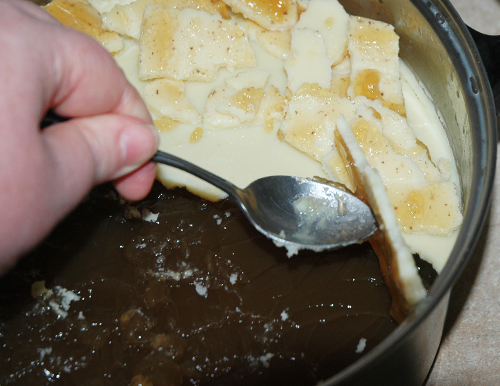 I am using a spoon to gently lift the fat off of the congealed stock. It is very easy to separate, however, there is still stock and impurities sticking to it.
I am using a spoon to gently lift the fat off of the congealed stock. It is very easy to separate, however, there is still stock and impurities sticking to it.
You can see the difference in colour between the fat that was rendered during roasting and the fat skimmed off of the stock.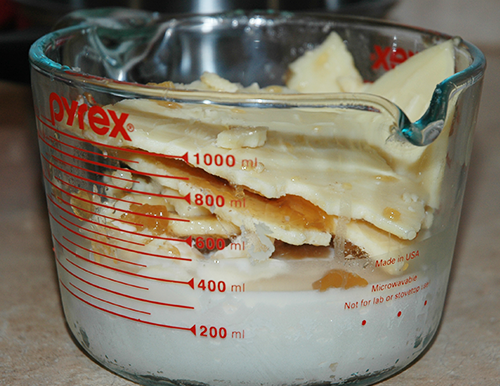 The fat from the roasting step is much more pure than the stock fat because the fat from the stock absorbs a little bit of extra stuff while simmering. Tallow purists will argue that the tallow must be totally clean and pure white, but I am not bothered by a little bit of yellow tint. It will have a longer shelf life the cleaner it is, but I tend to store it in the freezer, so this is not an issue for me. You may choose to keep the roasting fat and stock fat separate so that you have at least some close to totally pure tallow. It is a personal preference thing.
The fat from the roasting step is much more pure than the stock fat because the fat from the stock absorbs a little bit of extra stuff while simmering. Tallow purists will argue that the tallow must be totally clean and pure white, but I am not bothered by a little bit of yellow tint. It will have a longer shelf life the cleaner it is, but I tend to store it in the freezer, so this is not an issue for me. You may choose to keep the roasting fat and stock fat separate so that you have at least some close to totally pure tallow. It is a personal preference thing.
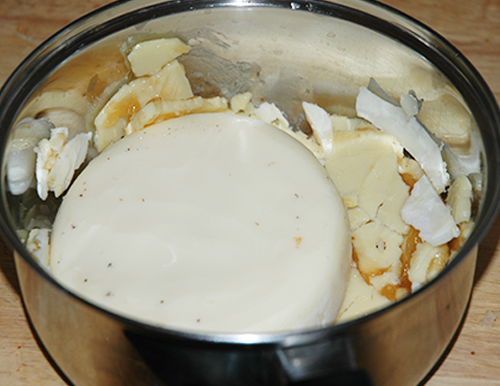 So, put all of the fat into a pot and heat it gently on a very low heat, just until it melts. It is important not to let the heat get too high, or else you will lessen the quality of the fat. It should only feel tepid once it is all melted.
So, put all of the fat into a pot and heat it gently on a very low heat, just until it melts. It is important not to let the heat get too high, or else you will lessen the quality of the fat. It should only feel tepid once it is all melted.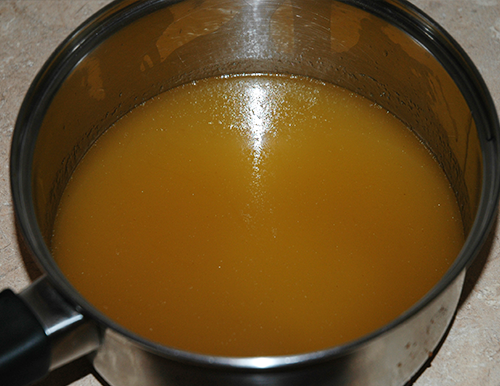
Now that it is melted all the fat will float to the top and most liquid and impurities that were left will settle to the bottom.
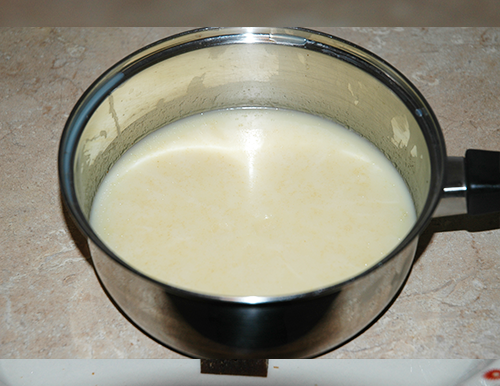 Put the fat into a container of some kind (I am just using the pot that I used to melt it in) into the refrigerator and leave it for a few hours until it is totally solid again.
Put the fat into a container of some kind (I am just using the pot that I used to melt it in) into the refrigerator and leave it for a few hours until it is totally solid again.
Once it solidifies you want to cleanly remove it from the pot. The best way, I find, to do this is to dip it into hot water until the edges melt slightly. Then when you turn it over onto a plate, it will easily slide out.
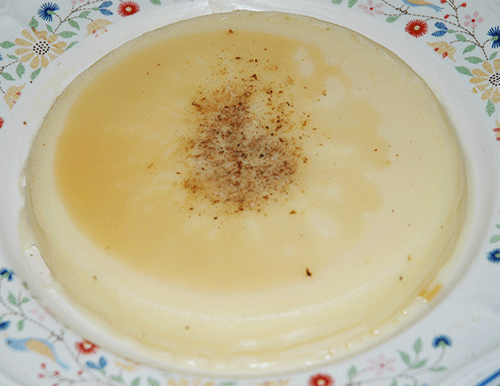 Now that you have flipped the fat upside down onto a plate, all of the impurities are visible on top. Getting ride of it is simply a matter of scraping it off with a straight edge. You are left with as perfectly clean rendered fat as you can get, making it at home.
Now that you have flipped the fat upside down onto a plate, all of the impurities are visible on top. Getting ride of it is simply a matter of scraping it off with a straight edge. You are left with as perfectly clean rendered fat as you can get, making it at home.
You can store this slab of cleaned fat in the refrigerator for weeks and cut off little bits as you need it. I honestly do not know the true shelf life, but some say it keeps for years. Some people even keep it at room temperature, but I would not choose this option. I like to play it very safe by freezing it. That way there is no question whether or not it has gone off.
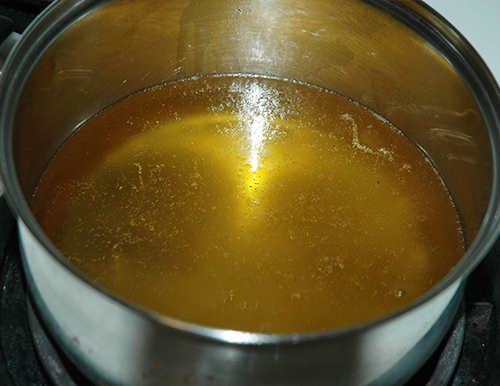 I also find it really convenient to freeze my fat in ice cube trays so that I can always grab a cube and get down to work, no fuss. So I simply melt the fat again, at low heat. All this melting and solidifying is not harming the fat, by the way. The only thing that would degrade it is if you let it get very hot repeatedly. Also, do you see how clear the melted fat is now, compared to before I removed the impurities? That is a job well done.
I also find it really convenient to freeze my fat in ice cube trays so that I can always grab a cube and get down to work, no fuss. So I simply melt the fat again, at low heat. All this melting and solidifying is not harming the fat, by the way. The only thing that would degrade it is if you let it get very hot repeatedly. Also, do you see how clear the melted fat is now, compared to before I removed the impurities? That is a job well done.
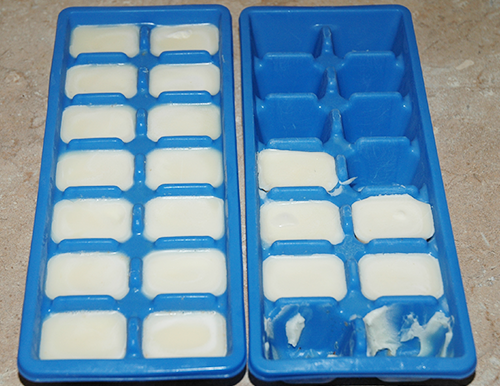 Now I simply fill ice cube trays with the tallow and freeze it. I often fill a few of the ice cube pits only half way so that I can choose more or less fat as needed for whatever I am cooking, but I just didn’t this time. The cubes come out very easily, just like ice cubes. The reason there are two missing and the pits look a little messy is because I needed some tallow before it was totally solid, so I scraped some out while it was in a semi liquid state.
Now I simply fill ice cube trays with the tallow and freeze it. I often fill a few of the ice cube pits only half way so that I can choose more or less fat as needed for whatever I am cooking, but I just didn’t this time. The cubes come out very easily, just like ice cubes. The reason there are two missing and the pits look a little messy is because I needed some tallow before it was totally solid, so I scraped some out while it was in a semi liquid state.
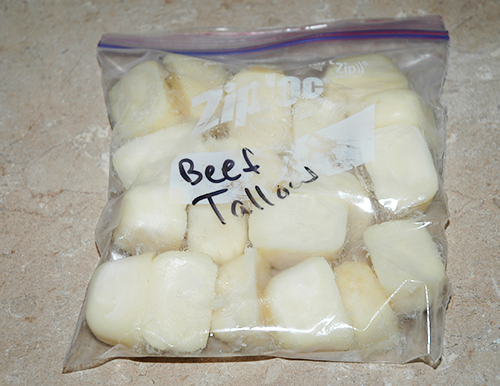 Once all the cubes are solid I throw them into a zipper freezer bag, and label it. Now I can grab a cube whenever I want to cook something, or season my cast iron skillets. This stuff is culinary GOLD!
Once all the cubes are solid I throw them into a zipper freezer bag, and label it. Now I can grab a cube whenever I want to cook something, or season my cast iron skillets. This stuff is culinary GOLD!


Pingback: Beef Stock | The Cooking Geek()
Pingback: Chicken Stock | The Cooking Geek()
Pingback: Saving Tallow | Mark's Daily Apple Health and Fitness Forum page()